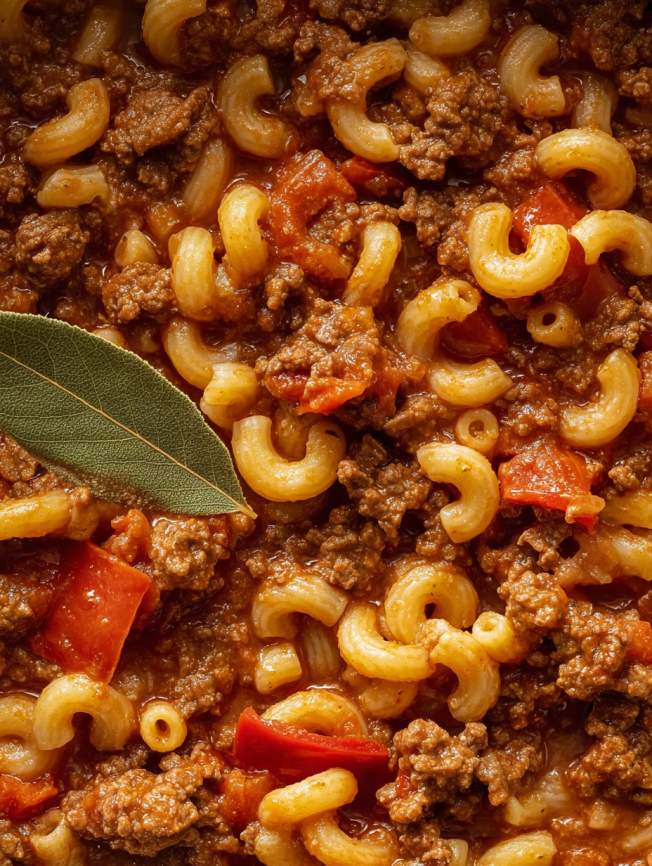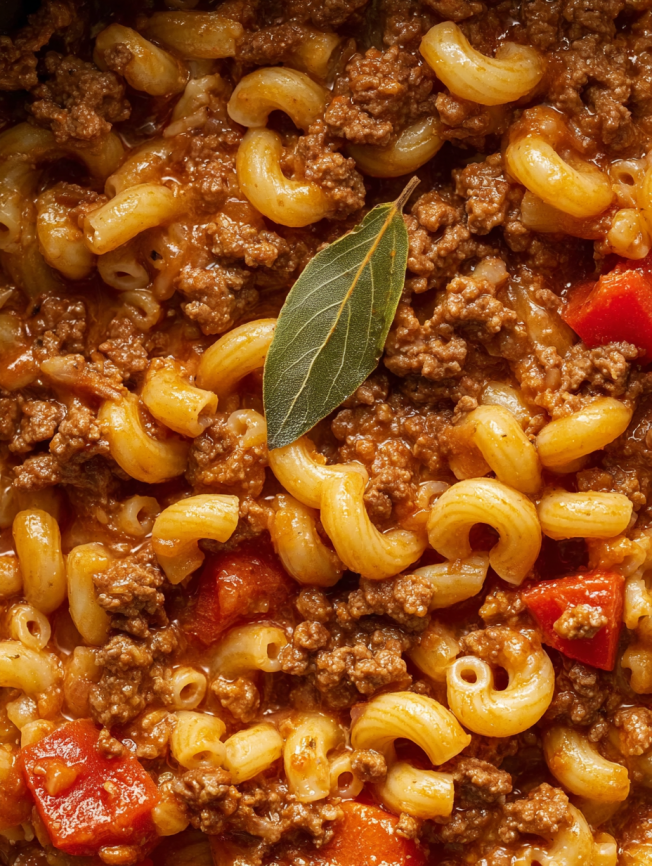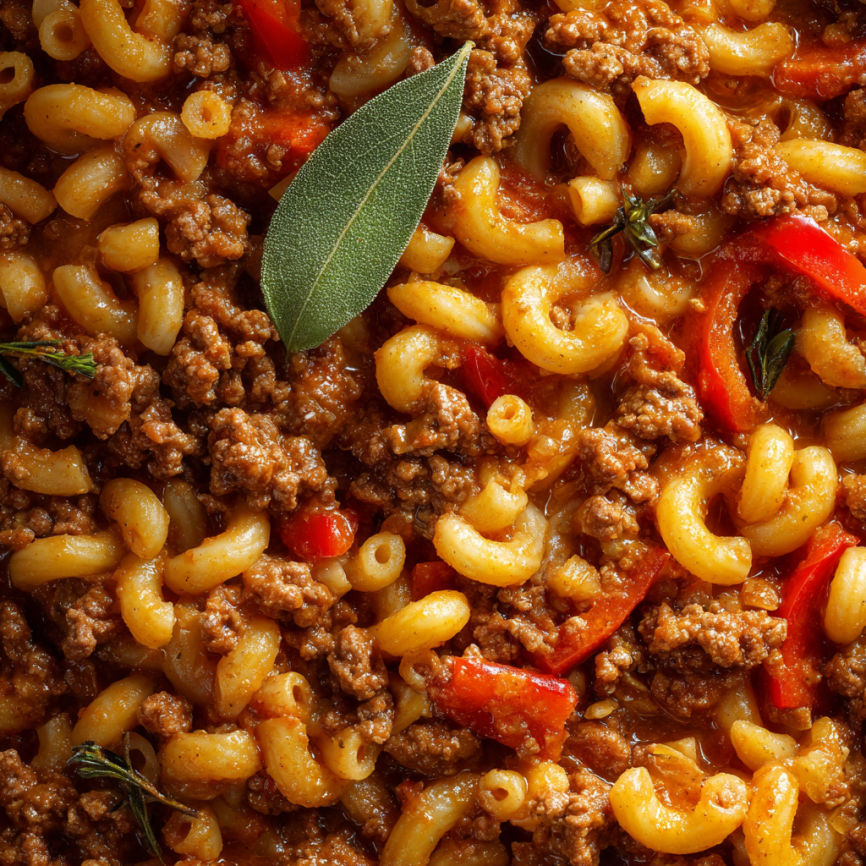Total Time: 40 minutes | Prep Time: 10 minutes | Cook Time: 30 minutes | Cuisine: American
Growing up in my grandmother’s kitchen, the aroma of simmering goulash would fill the entire house on Sunday afternoons. This wasn’t the paprika-heavy Hungarian version you might expect, but rather the beloved American-style goulash that became a staple in households across the country. My family’s recipe has been passed down for generations, and every time I make it, I’m transported back to those cozy Sunday dinners where everyone gathered around the table.
This Old-Fashioned Goulash represents everything wonderful about comfort food – it’s hearty, satisfying, and brings people together. Moreover, it’s incredibly practical for today’s busy families, requiring just one pot and simple ingredients you likely already have in your pantry.
Why You’ll Love This Old-Fashioned Goulash
It’s a Complete One-Pot Meal Unlike many pasta dishes that require multiple pots and pans, this goulash cooks everything together in one vessel. The pasta absorbs the rich, savory flavors as it cooks directly in the sauce, creating a cohesive dish where every bite is perfectly seasoned.
Budget-Friendly Comfort Food Ground beef, pasta, and pantry staples come together to create a meal that feeds a crowd without breaking the bank. Furthermore, this recipe easily doubles or triples for larger families or meal prep sessions.
Incredible Flavor Development The combination of beef broth, tomatoes, and umami-rich ingredients like soy sauce and Worcestershire creates layers of flavor that taste like they’ve been simmering for hours. Additionally, the pasta cooking directly in the sauce means it absorbs every drop of that delicious flavor.
Perfect for Busy Weeknights With just 40 minutes from start to finish, this goulash fits perfectly into hectic schedules. Meanwhile, it’s substantial enough to satisfy hungry family members and keep everyone full until morning.
Ingredients You’ll Need
Main Components
- Ground Beef (1 ½ lbs) – The protein foundation that adds rich, savory depth to every bite
- Elbow Macaroni (2 cups, uncooked) – Classic pasta shape that perfectly captures and holds the sauce
- Onion (1 large, diced) – Provides sweetness and aromatic foundation
- Garlic (3 cloves, minced) – Essential for building complex flavor layers
Sauce Base
- Diced Tomatoes (1 can, 28 oz, with juice) – Creates the rich, chunky tomato foundation
- Tomato Sauce (1 can, 15 oz) – Adds smooth consistency and concentrated tomato flavor
- Beef Broth (2 cups) – Contributes deep, meaty undertones that complement the ground beef
Flavor Enhancers
- Soy Sauce (1 tbsp) – Secret ingredient that deepens umami complexity
- Worcestershire Sauce (1 tbsp) – Adds subtle tang and depth
- Paprika (1 tsp) – Provides gentle warmth and beautiful color
- Italian Seasoning (1 tsp) – Herb blend that rounds out the flavor profile
- Salt & Black Pepper (to taste) – Essential for proper seasoning balance
- Bay Leaves (2) – Infuse the entire dish with aromatic warmth
Optional Additions
- Cheddar Cheese (1 cup, shredded) – For those who love an extra creamy, cheesy finish
Step-by-Step Instructions
Preparing the Base
Step 1: Brown the Beef Heat a large, heavy-bottomed pot over medium heat. Add the ground beef and cook for 6-8 minutes, breaking it apart with a wooden spoon as it browns. The key is achieving a nice caramelization on the meat, which adds incredible depth to the final dish. Once browned, drain any excess grease if necessary, leaving just enough to sauté the vegetables.
Step 2: Build the Aromatic Foundation Add the diced onion to the same pot with the browned beef. Sauté for 3-4 minutes until the onion becomes translucent and fragrant. Next, add the minced garlic and cook for an additional minute, stirring constantly to prevent burning. This aromatic base will perfume the entire dish.
Creating the Sauce
Step 3: Develop the Rich Sauce Stir in the diced tomatoes with their juice, tomato sauce, and beef broth. Then, add the soy sauce, Worcestershire sauce, paprika, Italian seasoning, bay leaves, and season generously with salt and pepper. Bring the mixture to a gentle boil, then reduce heat and let it simmer uncovered for 15 minutes, stirring occasionally. This simmering time allows all the flavors to meld beautifully.
Final Assembly
Step 4: Cook the Pasta Add the uncooked elbow macaroni directly to the simmering sauce. Stir well to ensure the pasta is completely submerged in the liquid. Cover the pot and continue cooking for 12-15 minutes, stirring every few minutes to prevent sticking. The pasta will absorb the flavors while cooking, creating that signature goulash taste.
Step 5: Finish and Serve Remove the bay leaves and discard them. If using cheese, stir it in during the last minute of cooking until melted and creamy. Taste and adjust seasoning as needed before serving hot.
Serving Suggestions
Classic Accompaniments
This hearty goulash pairs beautifully with simple sides that complement rather than compete with its rich flavors. Consider serving alongside warm dinner rolls or crusty bread for sopping up every last drop of sauce. A crisp green salad with vinaigrette provides a refreshing contrast to the dish’s richness.
Family-Style Presentation
Serve directly from the pot for a casual, family-style meal that encourages seconds and thirds. Alternatively, ladle into individual bowls and garnish with fresh chopped parsley or additional shredded cheese for a more polished presentation.

Recipe Variations
Cheesy Goulash Supreme
Transform this classic into an ultra-indulgent version by stirring in cream cheese along with the cheddar. The result is an incredibly creamy, restaurant-quality dish that will have everyone asking for the recipe.
Vegetable-Packed Version
Boost the nutritional value by adding diced bell peppers, corn, or peas during the last few minutes of cooking. These vegetables add color, texture, and extra vitamins without compromising the dish’s comforting nature.
Spicy Southwestern Twist
Give your goulash a kick by adding diced jalapeños, chili powder, and cumin to the spice blend. Top with pepper jack cheese instead of cheddar and garnish with fresh cilantro for a completely different flavor profile.
Lighter Version
Substitute ground turkey for beef and use whole wheat pasta for a healthier take. Additionally, you can reduce the cheese or skip it entirely while still maintaining the dish’s satisfying qualities.
Make-Ahead Tips
Preparation Strategies
This goulash actually improves with time, making it perfect for meal prep. Cook the entire recipe as directed, then cool completely before storing in the refrigerator for up to 4 days. The flavors continue to develop, resulting in an even more delicious meal.
Freezing Instructions
Prepare the goulash but slightly undercook the pasta since it will continue cooking when reheated. Cool completely, then freeze in portions for up to 3 months. Thaw overnight in the refrigerator before reheating gently on the stovetop with a splash of broth if needed.
Reheating Guidelines
When reheating, add a small amount of beef broth or water to restore the proper consistency. Heat slowly over medium-low heat, stirring frequently to prevent sticking and ensure even heating throughout.
Notes
- Pasta Perfection: Keep a close eye on the pasta during cooking and stir frequently to prevent sticking. The pasta should be tender but not mushy.
- Flavor Boost: For extra richness, brown the ground beef in batches to ensure proper caramelization rather than steaming.
- Cheese Options: While cheddar is traditional, feel free to experiment with mozzarella, Monterey Jack, or even a sharp white cheddar for different flavor profiles.
- Consistency Control: If the goulash becomes too thick, simply add more beef broth. Conversely, if it’s too thin, simmer uncovered for a few additional minutes.
- Spice Level: Adjust the heat by adding red pepper flakes, hot sauce, or diced jalapeños according to your family’s preferences.

Frequently Asked Questions
Can I use a different type of pasta?
Absolutely! While elbow macaroni is traditional, penne, rotini, or shells work equally well. Choose shapes with curves or ridges that capture the sauce effectively. However, avoid long pasta like spaghetti or linguine, as they don’t distribute as evenly in this one-pot method.
What’s the difference between American and Hungarian goulash?
Hungarian goulash is actually a soup made primarily with beef, vegetables, and lots of paprika, served over potatoes or dumplings. American goulash, like this recipe, is more of a pasta casserole with ground beef, tomatoes, and pasta cooked together in one pot.
Can I make this dish vegetarian?
Certainly! Replace the ground beef with plant-based ground meat or extra vegetables like mushrooms, bell peppers, and zucchini. Use vegetable broth instead of beef broth, and add extra seasonings to compensate for the missing meat flavors.
How do I prevent the pasta from getting mushy?
The key is timing and stirring. Add the pasta when there’s enough liquid in the pot, stir frequently to prevent sticking, and test for doneness starting at 10 minutes. Remember that the pasta will continue cooking slightly even after you remove it from heat.
Can I double this recipe?
Yes, this recipe doubles beautifully! Use a larger pot to accommodate the increased volume, and you may need to extend the cooking time slightly. This makes it perfect for feeding large groups or preparing multiple meals for the week.
What should I do if my goulash is too salty?
If you’ve over-seasoned, add a peeled, quartered potato to the pot during the last 10 minutes of cooking. The potato will absorb excess salt. Remove it before serving. Alternatively, stir in a small amount of sugar or a splash of cream to balance the saltiness.
How long will leftovers keep?
Properly stored leftovers will keep in the refrigerator for up to 4 days. The flavors actually continue to develop, making day-two goulash often even more delicious than the original meal. Just add a splash of broth when reheating to restore the proper consistency.

